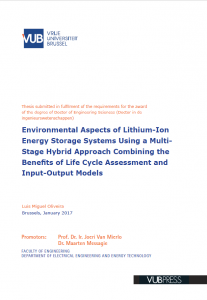
As seen in many other studies, the role of electric vehicles (EV) is the main driver for a global reduction of the emissions and impacts associated to personal transportation. When compared to conventional vehicles, with internal combustion engines, the electric vehicles produce fewer environmental impacts. Further analysis showed that the battery system is the culprit for signi cant burdens during the manufacturing stage. Being the lithium ion battery the most advanced and performant battery, this speci c part of the EV deserved attention. Mostly often, the battery, after 80% state of health (SOH) is not considered ef cient for vehicle use and thus, is discarded. This study assesses the environmental impacts and the merit of Nickel Manganese Cobalt (NMC) batteries to perform during rst life in a vehicle and in a second life under a photovoltaic household application until a SOH of 60% is reached. Using Life Cycle Assessment (LCA) methodology, a process based inventory of the battery components was elaborated together with industrial battery manufacturers and battery material suppliers. A remanufacturing inventory, based on a cost structure, was used to calculate the environmental impacts of the remanufacturing stage (which repurposes the vehicle battery in smaller modules) using economic input-output indicators. The results showed that the environmental impacts of the battery system are mostly pronounced during rst use and manufacturing, with the second life stage at the household level, unleashing the full potential for the lifecycle value of the battery itself. This thesis contributes to science with the most updated and detailed NMC lithium ion battery life cycle inventory; a cost model adapted to the Belgian case; a calculation framework to calculate the midpoint environmental impacts of nal demand vectors; a decision tree to aid the LCA practitioner on how to select and proceed with a LCA study when faced with multiple inventory possibilities. Alongside, suggestions based on the limitations of speci c inventory analysis are given during each step in order to help future LCA practitioners perform a battery related hybrid LCA.
